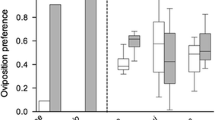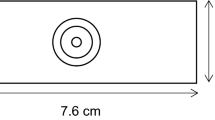Summary
Some butterfly species avoid egg-laying on plants which already bear conspecific eggs, and thus reduce food competition between their offspring. In twoPieris species the females produce in their accessory glands an oviposition-deterring pheromone (ODP), which is combined with the egg during oviposition. The ODP collected from eggs or accessory glands ofP. brassicae inhibits oviposition byP. rapae and vice versa. The ODP of either species stimulates tarsal receptors in both species. The antennae of the two pierids respond to the volatiles of their own and each other's eggs. Thus the ODPs of the two species may reduce not only intraspecific, but also interspecific food competition between their larvae.
Similar content being viewed by others
References
Kirby, W., and Spence, W., An Introduction to Entomology. Longman, London 1863.
Rothschild, M., and Schoonhoven, L. M., Nature266 (1977) 352.
Behan, M., and Schoonhoven, L. M., Ent. exp. appl.24 (1978) 163.
Klijnstra, J. W., and Roessingh, P., Ent. exp. appl.40 (1985) 71.
Rothschild, M., Alborn, H., Stenhagen, G., and Schoonhoven, L. M., Phytochemistry27 (1988) 101.
Schoonhoven, L. M., Beerling, E., Braaksma, R., and van Vugt, Y., J. chem. Ecol. (1990) in press.
Terofal, F., Mitt. Münch. ent. Ges.55-56 (1965) 1.
Ma, W. C., and Schoonhoven, L. M., Ent. exp. appl.16 (1973) 343.
Hodgson, E. S., Lettvin, J. Y., and Roeder, K. D., Science122 (1955) 417.
Frazier, J. L., and Hanson, H. E., in: Insect-Plant Interactions, pp. 285–330. Eds J. R. Miller and T. A. Miller, Springer, New York 1986.
Schoonhoven, L. M. (1990) unpublished.
Geiger, H. J., and Scholl, A., Experientia41 (1985) 24.
Prokopy, R. J., in: Semiochemicals, their Role in Pest Control, pp. 181–213. Eds D. A. Nordlund, R. L. Jones and W. J. Lewis, Wiley, New York 1981.
Feltwell, J., Large White Butterfly, the Biology, Biochemistry and Physiology ofPieris brassicae (Linnaeus). W Junk, The Hague 1982.
Metcalf, C. L., and Flint, W. P., Destructive and Useful Insects. McGraw-Hill, New York 1962.
Noldus, L. P. J. J., and van Leuteren, J., Med. Fac. Landbouw. Rijksuniv. Gent.48/2 (1983) 183.
Author information
Authors and Affiliations
Rights and permissions
About this article
Cite this article
Schoonhoven, L.M., Beerling, E.A.M., Klijnstra, J.W. et al. Two related butterfly species avoid oviposition near each other's eggs. Experientia 46, 526–528 (1990). https://doi.org/10.1007/BF01954255
Received:
Accepted:
Published:
Issue Date:
DOI: https://doi.org/10.1007/BF01954255




